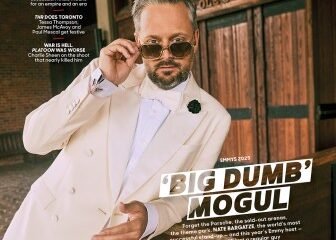Top Stories
‘Aka Charlie Sheen’ Director On Actor’s Crazy Revelations & Addiction

In the Netflix documentary aka Charlie Sheen, Director Andrew Renzi (Pepsi, Where’s My Jet?) was able to chronicle the rise and fall of the Two and a Half Men actor by relying on old family films, interviews with pals like Chris Tucker and Sean Penn and an extraordinary chat with Sheen’s former drug dealer Marco.
But the hallmark of the two-parter that dropped Sept. 10 was Renzi’s eye-popping interviews with the actor himself. “I take it very seriously that I’m making something that ultimately creates a legacy piece for somebody,” Renzi tells Deadline. “This is the Charlie Sheen documentary, and there probably can’t be another one. He has been such a privilege to work with because he had no editorial control over this thing, but he’s able to look at it and say, “all right, good, bad, all the things. This is an honest portrait of me that I feel like was representative of my POV, which was what I chose to do.” It’s a nice feeling to be able to walk away and say, okay, he’s good with it. I’m good with it. My hands are clean. ”
Here, Renzi explains how long the doc was in the works, why family members didn’t participate, and how Marco of all people helped Sheen to get off crack.
DEADLINE Give us the origin story. Why Charlie Sheen?
ANDREW RENZI I wanted to enter the celebrity doc conversation through someone who felt more like me, maybe a controversial figure. Maybe somebody who’s not so perfect. Charlie came to mind and I was able to get connected to him. We spent about eight months to a year getting to know each other before we shot a frame of the film. There was a long process of really figuring out whether this was even going to be a good idea. So from start to finish, it was about two years. It took some convincing. I didn’t know Charlie. I knew Charlie through the historical record of the internet, you know what I mean? I certainly didn’t know eight-years-sober Charlie Sheen. And I think that that was an amazing thing to experience. The only Charlie that I’ve ever known is a Charlie who’s sober. That played a big role in us telling this story. I don’t think he would’ve been able to do this eight years ago. So yeah, there was a long process of him understanding what the value of this would be.
DEADLINE How did you come up with the title?
RENZI Everyone has their own idea of who Charlie is. Everyone has their own idea of what they remember from him or what they want him to be like. I just found that to be a really provocative concept because a lot of this documentary seemed to be him unpacking that himself. And the obvious is that [he was born with the name of] Carlos Estevez. I just find it to be a really interesting detail. It’s like the guy’s not even Charlie Sheen, legally. So who is this guy? It was one of those things I threw down on paper one day and I was like, that’s the one. And no one argued.
DEADLINE Did you do two parts just so you can use the phrase Part Deux, a callback to Sheen’s 1993 film Hot Shots! Part Deux?
RENZI Listen, if there was three parts, I would’ve done the same thing. There were a lot of iterations with this project. I had a feature at one point in my head. But the two parts were really born out of the fact that I wanted part one to feel like a romanticized version of what drug addiction can look like to a drug addict, like a Hollywood rocket ship … sex, drugs, and rock & roll recreations, almost make it feel sensational to a degree. And then in part two, have it all fall apart, just really peel back what it actually looks like to be in the depths of addiction. The only natural format was two parts.
DEADLINE You started with the Two and a Half Men theme and Jon Cryer saying, “I’m not here to build him up or tear him down.” Why was that your start?
RENZI I think it was important to ground the audience with what, perhaps, is the most iconic thing about Charlie, despite all of the iconography around him. And the disarming nature of someone like Jon Cryer starting this thing felt good to me rather than just launching right into the chaos. I also really love the thematic concept of whether this a good idea. Is this a bad idea for me to be here sitting in front of you telling the story because of the cycle that has been his life? I just found that to be an urgent message for the doc. Is this going to open Pandora’s box again? Or is he truly sober and feeling better and in a different place?
DEADLINE Then you kicked off the anecdote where he actually flew a plane on his honeymoon!
RENZI That to me felt like the most Charlie Sheen in a nutshell that I could have possibly imagined. Here’s a guy who’s just married, on his honeymoon, drunk off his ass, and being given the steering wheel to a plane with 400 people behind him. That sort of power and mind fuck can’t be quantified by anyone else in the world. That is such a specific experience for him to have. It was a power that no one else could experience. If anyone ever had any questions about why a guy didn’t get sober sooner, there’s your answer. You keep getting the fucking plane.
DEADLINE You had a treasure trove of family super 8 footage to draw from.
RENZI It was so cool. His sister was the family archivist and quite literally just had a box of undeveloped film. No one had seen those things. So I got to edit together Charlie Sheen’s directorial efforts at age 8 as though he was doing it. I had hours and hours and hours of dailies that somebody, hopefully, gets to mine again and do something more with. I mean, there’s Sean Penn setting up camera angles for Charlie at age 10. There was a different iteration at one point of this project that dove a lot deeper into Charlie and Chris Penn’s relationship. Everyone’s a little kid at some point. Not everyone’s a little kid though that gets to make super 8 movies because they were on the set of Apocalypse Now.
DEADLINE You didn’t delve into Chris Penn, but you spent some time on Charlie’s friendship with Nicholas Cage. Why?
RENZI I think Nic Cage was a turning point. It was that moment in Charlie’s life where he became a superstar that also was going to march to the beat of his own drum. I think that union, that sort of unholy union, was pretty cool. Not many people knew they had this pocket of time together. It felt like such a fun way for the audience to be like, “well, yeah, if you’re going to become a superstar, who better to party with than Nic Cage?” It just set the tone for a lot of Charlie’s behaviors to come.
DEADLINE It’s extraordinary that you got his old drug dealer Marco to talk. I had many questions about how he cleaned up the crack at the end to help Charlie get sober.
RENZI Apparently it’s just extra baking soda every time. Not to give too much of an infomercial on how to cook crack, but you mix baking soda and cocaine together and you create crack. So he just kept making more and more with baking soda. Eventually there was just no crack, no cocaine in it. Charlie was just smoking baking soda.
DEADLINE I can’t believe you had video of the moment when Charlie found out he was fired from Two and a Half Men.
RENZI One of the guys who was following Charlie around a lot was a paparazzo. Eventually Charlie was like, “listen, you’re jumping out of bushes all the time on me. Just come with me.” And he ended up working for him and being a videographer for him at all times. This guy ended up with Charlie at the worst time of his life. Charlie was like, “oh my God. There was a guy with a camera there the whole time. We got to find the footage.” No one knew if it existed anymore. It turned out to be in a storage unit in Colorado or something, and this guy just handed it over to me and allowed us to use it.
DEADLINE What was it like to listen to him discuss how his time on Two and a Half Men went up in flames?
RENZI It was a pretty unique experience. It was a little bit of like, “oh my God, was that me?” I think of all the things, having to look back at that moment in his life was the hardest. He really struggled with his behavior, the aggression, the sort of feeling like he was being a bully. He’s not a bully. He’s not that guy. I think it was hard for him to say how he treated Chuck Lorre, how he treated Jon Cryer, how he talked about things on the air, how he came at people. I think that made him feel the ick probably more than anything. I think shame is a thing that will haunt anybody who has experiences they’re not proud of. He didn’t make this documentary as an amends because he’s been living those amends for the past eight years.
DEADLINE Why do you think Martin Sheen and Emilio Estevez declined to participate?
RENZI I actually watched the movie with them, so I got to sit next to Martin while he watched. It was one of the most intimidating moments of my life, but it was really just a function of Martin feeling as though Charlie’s message to his father was so present and maybe more available than him sitting for an interview. I don’t know if Martin wanted to sit down with me and relive all of that stuff. He felt like, this is Charlie’s moment to tell his story. You don’t need me. I respected the heck out of that. I mean, that’s a dad who really wants to just look out for his son and himself. And then Emilio, it just felt like he saw this as Charlie’s moment and Charlie was able to finally tell his story the way that he wanted to tell it. None of that ended up being controversial. Everyone was open about the communication. Those guys are minutes from each other, probably seeing each other on a weekly, daily basis. And so it was nice for me to know that it had nothing to do with whatever perceived rift there might be. It was quite the opposite. It was because of the love they all have for each other.
DEADLINE Do you think Charlie can truly explain why he’s an addict? Do you think he’s totally self-aware?
RENZI My perspective is he is arguably, at least from a public figure perspective, the biggest emblem of an addict that’s still alive. He went as deep as you can go without dying. For the past eight years, he was not only just figuring that out for himself, but not trying to do the thing that he had always done … that’s to re-enter the public conversation, get another role. He truly went away to figure this out. And that’s pretty rare. Eight years is a heck of a stretch for anyone to go and reconcile with those things. So I’d have to say yes. I felt like when I was sitting across from him, I always thought, this is a person who’s honest, who maybe isn’t going to give everybody what they want, but he’s here and he’s present and he’s telling his own truth. That to me is a very specific type of success story.
DEADLINE Did you enjoy talking to him?
RENZI He’s hilarious. For a story that could be this dark, what a gift to be able to recount some of these things, but with a tone that doesn’t need to be wildly investigative and uncomfortable and unsettling. I felt privileged.
Top Stories
Mortgage rates drop to 3-year low ahead of Fed meeting

A completed planned development is seen in Ashburn, Virginia, on Aug. 14, 2024.
Andrew Caballero-Reynolds | AFP | Getty Images
Mortgage rates dropped sharply Tuesday, as investors in mortgage-backed bonds seemed to buy in ahead of a widely expected rate cut by the Federal Reserve.
The average rate on the 30-year fixed mortgage dropped 12 basis points from Monday to 6.13%, according to Mortgage News Daily. That is the lowest level since late 2022.
“The overall set-up is reminiscent of September 2024 when rates were doing the same thing for the same reasons ahead of Fed meeting with a virtual 100% chance of a rate cut,” said Matthew Graham, chief operating officer of Mortgage News Daily. “Back then, mortgage rates moved paradoxically higher after the Fed rate cut. The same thing could happen this time, but it’s by no means guaranteed.”
It also follows historical trends. In a video podcast for CNBC’s Property Play, Willy Walker, CEO of commercial real estate firm Walker & Dunlop said there have been similar trends in the past.
“If you go back to 1980 and the nine Fed rate cut periods over that 45-year period, the ones where the Fed cuts in a recessionary environment end up pulling down the long end of the curve, pull down the 10-year, pull down the 5-year,” Walker said. “In those where it’s not a recession, which is like right now, it does not impact long-term rates. And so as much as I’m expecting us to see at least a 25 basis point cut, and then probably another 25 basis point cut, even if you take 50 basis points out of the short end of the curve, I don’t expect it’s going to impact the long end of the curve very much.”
He added that he thinks yields are well below where they will be two or three weeks from now.
“I don’t try to predict where rates are going, but I think people … might buy on the rumor and sell on the news. I think you probably see the 10-year sell off a little bit after the Fed actually announces their 25 basis point cut,” Walker said.
Top Stories
Robert Redford dies at 89
Robert Redford, the Hollywood golden boy who became an Oscar-winning director, liberal activist and godfather for independent cinema under the name of one of his best-loved characters, died Tuesday at 89.
Redford died “at his home at Sundance in the mountains of Utah — the place he loved, surrounded by those he loved,” publicist Cindi Berger said in a statement. He died in his sleep, but no cause was provided.
After rising to stardom in the 1960s, Redford was one of the biggest stars of the ’70s with such films as “The Candidate,” “All the President’s Men” and “The Way We Were,” capping that decade with the best director Oscar for 1980’s “Ordinary People,” which also won best picture in 1980. His wavy blond hair and boyish grin made him the most desired of leading men, but he worked hard to transcend his looks — whether through his political advocacy, his willingness to take on unglamorous roles or his dedication to providing a platform for low-budget movies.
His roles ranged from Washington Post journalist Bob Woodward to a mountain man in “Jeremiah Johnson” to a double agent in the Marvel Cinematic Universe, and his co-stars included Jane Fonda, Meryl Streep and Tom Cruise. But his most famous screen partner was his old friend and fellow activist and practical joker Paul Newman, their films a variation of their warm, teasing relationship off screen. Redford played the wily outlaw opposite Newman in 1969’s “Butch Cassidy and the Sundance Kid,” a box-office smash from which Redford’s Sundance Institute and festival got its name. He also teamed with Newman on 1973’s best picture Oscar winner, “The Sting,” which earned Redford a best-actor nomination as a young con artist in 1930s Chicago.
Listen to Paul Newman and Robert Redford in “Butch Cassidy and the Sundance Kid.”
Redford plays the wily outlaw opposite Newman’s Butch Cassidy.
Film roles after the ’70s became more sporadic as Redford concentrated on directing and producing, and his new role as patriarch of the independent-film movement in the 1980s and ’90s through his Sundance Institute. But he starred in 1985’s best picture champion “Out of Africa” and in 2013 received some of the best reviews of his career as a shipwrecked sailor in “All is Lost,” in which he was the film’s only performer. In 2018, he was praised again in what he called his farewell movie, “The Old Man and the Gun.”
“I just figure that I’ve had a long career that I’m very pleased with. It’s been so long, ever since I was 21,” he told The Associated Press shortly before the film came out. “I figure now as I’m getting into my 80s, it’s maybe time to move toward retirement and spend more time with my wife and family.”
Sundance is born
Redford had watched Hollywood grow more cautious and controlling during the 1970s and wanted to recapture the creative spirit of the early part of the decade. Sundance was created to nurture new talent away from the pressures of Hollywood, the institute providing a training ground and the festival, based in Park City, Utah, where Redford had purchased land with the initial hope of opening a ski resort. Instead, Park City became a place of discovery for such previously unknown filmmakers as Quentin Tarantino, Steven Soderbergh, Paul Thomas Anderson and Darren Aronofsky.
“For me, the word to be underscored is ‘independence,’” Redford told the AP in 2018. “I’ve always believed in that word. That’s what led to me eventually wanting to create a category that supported independent artists who weren’t given a chance to be heard.
“The industry was pretty well controlled by the mainstream, which I was a part of. But I saw other stories out there that weren’t having a chance to be told and I thought, ‘Well, maybe I can commit my energies to giving those people a chance.’ As I look back on it, I feel very good about that.”
Sundance was even criticized as buyers swarmed in looking for potential hits and celebrities overran the town each winter.
“We have never, ever changed our policies for how we program our festival. It’s always been built on diversity,” Redford told the AP in 2004. “The fact is that the diversity has become commercial. Because independent films have achieved their own success, Hollywood, being just a business, is going to grab them. So when Hollywood grabs your films, they go, ‘Oh, it’s gone Hollywood.’”
By 2025, the festival had become so prominent that organizers decided they had outgrown Park City and approved relocating to Boulder, Colorado, starting in 2027. Redford, who had attended the University of Colorado Boulder, issued a statement saying that “change is inevitable, we must always evolve and grow, which has been at the core of our survival.”
Redford’s affinity for the outdoors was well captured in “A River Runs Through It” and other films and through his decades of advocacy for the environment, inspired in part by witnessing the transformation of Los Angeles into a city of smog and freeways. His activities ranged from lobbying for such legislation as the Clean Air Act and Clean Water Act to pushing for land conservation in Utah to serving on the board of the Natural Resources Defense Council.
Listen to Robert Redford at the United Nations
In 2015, Robert Redford told the U.N. it needed to deal with climate change.
Redford was married twice, most recently to Sibylle Szaggars. He had four children, two of whom have died — Scott Anthony, who died in infancy, in 1959; and James Redford, an activist and filmmaker who died in 2020.
Redford’s early life
Robert Redford was born Charles Robert Redford Jr. on Aug. 18, 1936, in Santa Monica, a California boy whose blond good looks eased his way over an apprenticeship in television and live theater that eventually led to the big screen.
Redford attended college on a baseball scholarship and would later star as a middle-aged slugger in 1984’s “The Natural,” the adaptation of Bernard Malamud’s baseball novel. He had an early interest in drawing and painting, then went on to study at the American Academy of Dramatic Arts, debuting on Broadway in the late 1950s and moving into television on such shows as “The Twilight Zone,” “Alfred Hitchcock Presents” and “The Untouchables.”
Listen to Wilford Brimley and Robert Redford in ‘The Natural’
Redford starred as a middle-aged slugger in the adaptation of Bernard Malamud’s baseball novel.
After scoring a Broadway lead in “Sunday in New York,” Redford was cast by director Mike Nichols in a production of Neil Simon’s “Barefoot in the Park,” later starring with Fonda in the film version. Redford did miss out on one of Nichols’ greatest successes, “The Graduate,” released in 1967. Nichols had considered casting Redford in the part eventually played by Dustin Hoffman, but Redford seemed unable to relate to the socially awkward young man who ends up having an affair with one of his parents’ friends.
“I said, ‘You can’t play it. You can never play a loser,’” Nichols said during a 2003 screening of the film in New York. “And Redford said, ‘What do you mean? Of course I can play a loser.’ And I said, ‘OK, have you ever struck out with a girl?’ and he said, ‘What do you mean?’ And he wasn’t joking.”
Indie champion, mainstream star
Even as Redford championed low-budget independent filmmaking, he continued to star in mainstream Hollywood productions himself, scoring the occasional hit such as 2001’s “Spy Game,” which co-starred Brad Pitt, an heir apparent to Redford’s handsome legacy whom he had directed in “A River Runs Through It.”
Ironically, “The Blair Witch Project,” “Garden State,” “Napoleon Dynamite” and other scrappy films that came out of Sundance sometimes made bigger waves — and more money — than some Redford-starring box-office duds like “Havana,” “The Last Castle” and “An Unfinished Life.”
Redford also appeared in several political narratives. He satirized campaigning as an idealist running for U.S. senator in 1972’s “The Candidate” and uttered one of the more memorable closing lines, “What do we do now?” after his character manages to win. He starred as Woodward to Hoffman’s Carl Bernstein in 1976’s “All the President’s Men,” the story of the Washington Post reporters whose Watergate investigation helped bring down President Richard Nixon.
With 2007’s “Lions for Lambs,” Redford returned to directing in a saga of a congressman (Tom Cruise), a journalist (Meryl Streep) and an academic (Redford) whose lives intersect over the war on terrorism in Afghanistan.
His biggest filmmaking triumph came with his directing debut on “Ordinary People,” which beat Martin Scorsese’s classic “Raging Bull” at the Oscars. The film starred Donald Sutherland and Mary Tyler Moore as the repressed parents of a troubled young man, played by Timothy Hutton, in his big screen debut. Redford was praised for casting Moore in an unexpectedly serious role and for his even-handed treatment of the characters, a quality that Roger Ebert believed set “the film apart from the sophisticated suburban soap opera it could easily have become.”
Listen to Robert Redford discuss awards at the Sundance Film Festival
In 2016, Robert Redford said he did not make movies to win awards.
Redford’s other directing efforts included “The Horse Whisperer,” “The Milagro Beanfield War” and 1994’s “Quiz Show,” the last of which also earned best picture and director Oscar nominations. In 2002, Redford received an honorary Oscar, with academy organizers citing him as “actor, director, producer, creator of Sundance, inspiration to independent and innovative filmmakers everywhere.”
“The idea of the outlaw has always been very appealing to me. If you look at some of the films, it’s usually having to do with the outlaw sensibility, which I think has probably been my sensibility. I think I was just born with it,” Redford said in 2018. “From the time I was just a kid, I was always trying to break free of the bounds that I was stuck with, and always wanted to go outside.”
___
This story has been corrected to update Redford’s birth year to 1936, not 1937.
___
Associated Press journalists Hillel Italie, Jake Coyle and Mallika Sen contributed to this report. Bob Thomas, a longtime Associated Press journalist who died in 2014, was the principal writer of this obituary.
Top Stories
TikTok to stay in the US as Donald Trump says deal is done

Imran Rahman-JonesTechnology reporter
 Getty Images
Getty ImagesA deal has been made between the US and China to keep TikTok running in the US, according to President Donald Trump.
“We have a deal on TikTok, I’ve reached a deal with China, I’m going to speak to President Xi on Friday to confirm everything up,” Trump told reporters as he left the White House for a state visit to the UK.
The social media platform, which is run by Chinese company ByteDance, was told it had to sell its US operations or risk being shut down.
However, Trump has repeatedly delayed the ban since it was first announced in January. Later on Tuesday, he ordered the deadline extended again, until 16 December.
The US president said a buyer will be announced soon.
The Wall Street Journal reported that under a deal being negotiated between the US and China, TikTok’s U.S. business would be controlled by an investor consortium that would include tech company Oracle, private equity firm Silver Lake, and venture capital firm Andreessen Horowitz.
In a new US entity created under the deal, US investors would hold a roughly 80% stake and Americans would dominate the board, with one member selected by the US government, according to the Journal, which cited people familiar with the matter.
US users, meanwhile, would move to a new app, currently in the testing phase, that will have content-recommendation algorithms using technology licensed from ByteDance. TikTok’s algorithms are a top reason for the app’s success.
Earlier, CNBC reported the deal would include a mix of current and new investors, and would be completed in the next 30 to 45 days.
It also said Oracle would keep its existing agreement to host TikTok servers inside the US. That had been one of the main concerns of American lawmakers, over worries about data being shared with China.
On Monday, a US trade delegation said it had reached a “framework” deal with China amid wider trade negotiations in Madrid.
China confirmed a framework agreement but said no deal would be made at the expense of their firms’ interests.
After the talks, Wang Jingtao, deputy head of China’s cyberspace administration, suggested in a press conference that the agreement included “licensing the algorithm and other intellectual property rights”.
He added: “The Chinese government will, according to law, examine and approve relevant matters involving TikTok, such as the export of technology as well as the license use of intellectual property.”
After initially calling for TikTok to be banned during his first term, Trump has reversed his stance on the popular video-sharing platform.
In January, the US Supreme Court upheld a law, passed in April 2024, banning the app in the US unless its Chinese parent company ByteDance sold its US arm.
The US Justice Department has said that because of its access to data on American users, TikTok poses “a national-security threat of immense depth and scale”.
However, ByteDance has resisted a sale, maintaining its US operations are completely separate, and says no information is shared with the Chinese state.
TikTok briefly went dark in January, but this lasted for less than a day before the initial ban was delayed.
The deadline for a sale has since been extended four times, and the latest delay to the ban is due to end on 16 December.

-

 Business3 weeks ago
Business3 weeks agoThe Guardian view on Trump and the Fed: independence is no substitute for accountability | Editorial
-
Tools & Platforms1 month ago
Building Trust in Military AI Starts with Opening the Black Box – War on the Rocks
-

 Ethics & Policy2 months ago
Ethics & Policy2 months agoSDAIA Supports Saudi Arabia’s Leadership in Shaping Global AI Ethics, Policy, and Research – وكالة الأنباء السعودية
-

 Events & Conferences4 months ago
Events & Conferences4 months agoJourney to 1000 models: Scaling Instagram’s recommendation system
-

 Jobs & Careers3 months ago
Jobs & Careers3 months agoMumbai-based Perplexity Alternative Has 60k+ Users Without Funding
-

 Podcasts & Talks2 months ago
Podcasts & Talks2 months agoHappy 4th of July! 🎆 Made with Veo 3 in Gemini
-

 Education3 months ago
Education3 months agoVEX Robotics launches AI-powered classroom robotics system
-

 Education2 months ago
Education2 months agoMacron says UK and France have duty to tackle illegal migration ‘with humanity, solidarity and firmness’ – UK politics live | Politics
-

 Podcasts & Talks2 months ago
Podcasts & Talks2 months agoOpenAI 🤝 @teamganassi
-

 Funding & Business3 months ago
Funding & Business3 months agoKayak and Expedia race to build AI travel agents that turn social posts into itineraries



















